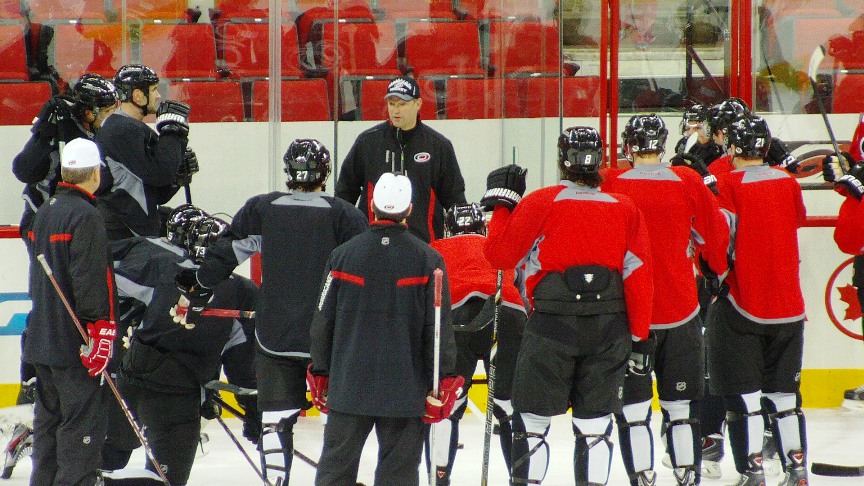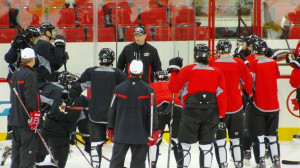

Peter Koutroumpis – editor@trianglesportsnet.com
RALEIGH, N.C. – Ron Francis’ recent firing of head coach Kirk Muller indicated that the Carolina Hurricanes were starting over again.
The team’s new executive vice president and general manager described the move as making a fresh start, so to speak.
With only assistant coach Rod Brind’Amour remaining to be a part of a new coaching staff that will be assembled upon hiring a new coach, hopefully within a month, the Hurricanes will wipe clean the whiteboard of what Muller and his staff worked on putting together for the past three years.
John MacLean and Dave Lewis, Muller’s assistants, were also let go while Greg Stefan returned to the Hurricanes pro scouting staff after working with the team’s goaltenders.
As a collective, the management staff led by now President Jim Rutherford and the coaching staff headed by Muller, compiled another three seasons of average results that eventually were tacked on as part of Carolina’s fifth consecutive season of not making the playoffs.
The end result showed that theirs and the players’ work in the end failed.
The goal was to make the playoffs and they didn’t.
However, to say that the team didn’t improve wouldn’t be entirely fair.
Francis noted that Muller’s circumstances were exceptional as he only really worked one full season, his most recent, from start to finish while using scotch tape and super glue to fit pieces that were brought in and reassembled to try to construct the perfect showpiece during his first two seasons.
Picking up the pieces from Paul Maurice back on Nov. 28, 2011, Muller’s first task was to get the confidence of captain Eric Staal back up to a level where he could lead the team offensively as he needed to.
He did that as Staal picked up his pace and level of output to what was expected of him, and to be at the top of the team’s scoring list.
When Muller stepped in, Staal sat with 11 points (5 goals, 6 assists) in 25 games, and eventually finished the season with 70 points (24 goals, 46 assists) – finishing the season tallying 59 points in 57 games.
Unfortunately, increasing Staal’s scoring output, even while weathering a significant concussion injury to Carolina’s other goal scorer, Jeff Skinner, during his sophomore season, didn’t get the team into the playoffs.
The improvement provided hope for the future and that was the first successful step made considering how the team began the 2011-2012 season.
Credit Muller for that.
If there’s one thing Muller did from the beginning was to point out that a long process was needed to get Carolina on track to be successful.
However, consistency in the roster was not something that developed and the coaching staff couldn’t develop a top-to-bottom effective functioning of the defensive chip-and-chase system that Muller, MacLean and Lewis implemented.
It was a system that required a high energy output with little room for error in transition from defense to offense and back.
With 60-plus players thrown into the cauldron over three seasons while trying to develop the right mix, the final product never developed the right flavor for management and the fans to savor.
From the 2011-2012 season until today, the Hurricanes have 11 players who are still on the team’s roster from front to back and includes Staal, Skinner, Jiri Tlusty, Patrick Dwyer, Riley Nash, Drayson Bowman, Justin Faulk, Joni Pitkanen (did not play in 2013-2014), Jay Harrison, Cam Ward, and Justin Peters.
For all intents and purposes, that has been the core of the Hurricanes roster made available for Muller and his staff to work with over three seasons.
Carolina’s season-ending rosters from 2012-2014 included 48 additional different players who were either brought up from the team’s AHL affiliate in Charlotte, were eventually traded for, traded away, or not re-signed.
Many were role players who were interchanged en masse during each offseason in order to complement the core.
Coming into the lockout-shortened 2012-2013 season, the offensive consistency that Muller was trying to find was anticipated to develop significantly with the addition of forwards Jordan Staal and Alexander Semin.
Many watching from the outside were giddy when pondering the possibilities of damage that both Staals, Semin, and Skinner could do in the offensive end of the ice at both even strength and on the power play.
However, the expectations were much higher than the results, and particularly so with the power play.
At the end of each season from 2012-2014, Carolina finished ranked 19th (16.67), 27th (14.55), and 28th (14.59) when compared to all other NHL extra-man units.
If there was a major failure that Muller and his staff could not correct with the talent available was in extra-man situations.
For what reason?
No one but Muller and those players know.
It was a problem that everyone knew about and one that eventually was never fully worked out while also never being fully explained.
On the other hand, the penalty kill, Carolina finished 22nd (80.56), 28th (77.64), and 17th (81.74) and did show the improvement during this past season that Muller was looking for.
His focus on the team’s defensive play did make major improvement this past season at even strength as the Hurricanes ended the season averaging 2.8 goals against per game versus 3.3 goal against last season.
However, that wasn’t a significant improvement over three seasons since the team ended the 2011-2012 season averaging 2.9 goals against.
In terms of even-strength offense, Carolina flat lined and regressed slightly, averaging 2.6 goals per game for the first two seasons under Muller’s watch, but stumbled and finished this past season scoring 2.5 goals per game.
When looking at the numbers, the basic math makes it obvious that not scoring more goals than you get scored against will not increase your chances of tallying enough wins to earn a playoff spot.
Muller’s final results in leading Carolina after three years showed improvements, but not enough and an 80-80-27 record showed that.
Inevitably, one final set of numbers that had to have forced Francis to make a change was to erase the feeling of letdown that resulted during the final stretch of each of the past three seasons.
Though the Hurricanes finished March and April in 2012 with a 9-7-3 record, their finish in 2013 (9-17-3) and 2014 (10-11-2) said a lot of what ultimately became an unsuccessful run for Muller and why they have continued to watch rather than play in the postseason.
Is Carolina a better defensive team now than it was when Muller took over?
Yes, slightly.
Are the Hurricanes underachieving offensively and is that Muller’s fault?
Maybe, maybe not.
Unfortunately, regardless of what measures, positive and negative, were used to evaluate his success and failure in leading Carolina, the gut feeling sitting with many at the end of the day was not a good one.
The concepts, the effort, the energy, and the incremental improvements he presented were never the issue.
The final result was.
